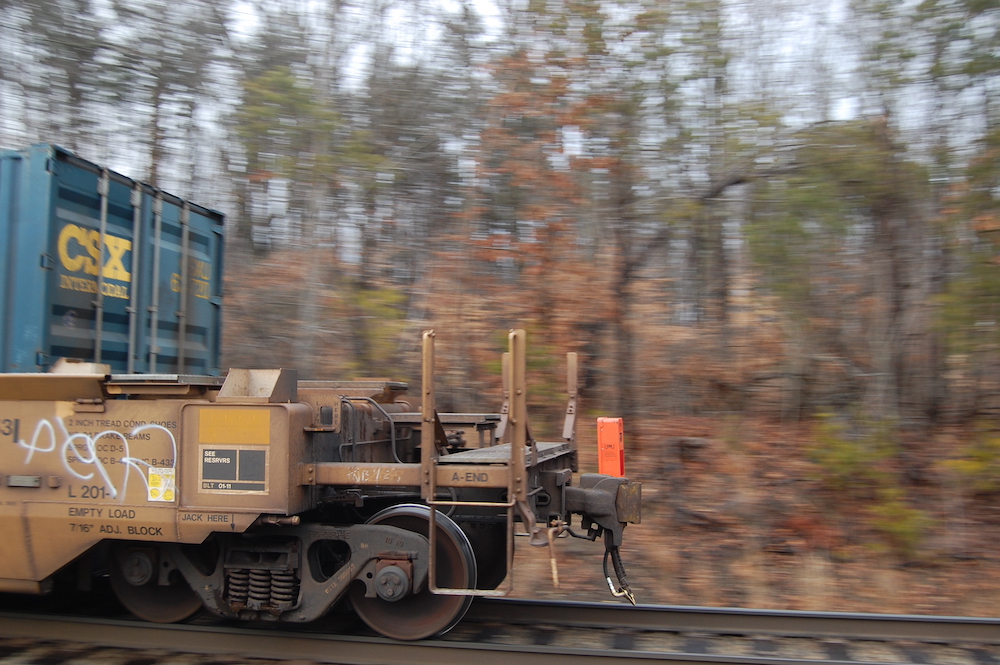
End-of-train devices replaced cabooses that, not so long ago, train watchers almost everywhere could count on as a final point of interest at the end of each freight train. The distinctive little cars housed crew members who would observe the cars ahead for defects, process the train’s paperwork, operate track switches, monitor the air-brake system to see if it was functioning throughout the train, observe if the train was moving or stopped as intended by the engineer, and apply the brakes in an emergency. Cabooses also carried marker lights to warn following trains.
But the caboose has yielded to other technology. Defect observation has been taken over by trackside detectors, the conductor now does his paperwork in the engine cab, and many mainline switches are thrown by remote control (though many others are still manual).
The caboose’s other functions are now performed by end-of-train telemetry, best represented by the end-of-train device (ETD), the small metal box with a flashing light on the rear coupler of the last car. Most ETDs are of the “smart” variety, so-called because of their ability to do a number of tasks.
Perhaps their most visible element is the flashing marker light. Powered by rechargeable batteries, the marker is controlled by a photoelectric cell which turns the flasher on when ambient light levels become low. (Many streetlights and yard lights work this way.) Reflective material, sometimes striped, on the exterior of the ETD is meant to catch the headlight beam of an approaching locomotive, so the unit still provides warning even if the ETD light has failed.
Another important ETD job is the monitoring of the brake-pipe pressure. A sensor extends down from the ETD unit (which, depending on the design, can be mounted on the knuckle or the side of the coupler) and attaches to the end of the air hose. This way, the ETD gathers data on the brakeline pressure, one of the most crucial measurements on any train. This information is transmitted by radio to the engine cab, which must have the equipment to receive, decode, and display the data. The engineer can thus monitor the integrity of the train line as he sets and releases the brakes.
ETDs are also equipped with sensors that determine the motion of the rear end. Radio transmissions from the unit tell the engine cab if the rear end is stopped or moving forward or backward. Information on the marker light (on or off) and batteries (how much charge is left) is also included in ETD radio messages. If there is a loss of radio continuity between the ETD and the cab, this will be displayed.
Florida East Coast pioneered ETD use in 1969, and most other railroads followed suit by the mid-1980s. Early units simply transmitted data to the cab. Now railroads are required to use “two-way” equipment. A two-way telemetry system allows the ETD to apply the train brakes on radio command from the engine crew, sometimes necessary in emergencies.
Other improvements have been a reduction in weight to under 30 pounds and an increase between battery rechargings to 6 days. (Throwaway batteries were used at first.) Only two manufacturers are currently producing ETDs: Pulse Electronics and Union Switch & Signal.
Each ETD is identified with its owner’s initials and a number. By entering the unique code of his train’s ETD in the cab equipment, the engineer sets up to receive the proper signals.
An ETD transmits data roughly every 40 seconds, but if it detects a change in train status, it sends a signal immediately. To facilitate run-through operations, the AAR has assigned the frequency of 457.9375 MHz to ETDs, though Norfolk Southern uses 161.115. Under favorable conditions, a signal will travel 3 to 5 miles. Special equipment is needed to interpret the ETD information, but the railfan with a scanner will hear an ETD as an intermittent chirp – a useful tool in finding trains.
Just as cabooses were variously called hacks, crummies, cabins, etc., end-of-train devices go by a variety of names. Besides ETD, there’s EOT, marker, FRED or Freddy (flashing rear-end device), and even Billy and Redman.
The simplest ETDs are merely darkness-actuated flashing lights that serve only as markers. They are referred to as “dumb,” to distinguish them from their more sophisticated counterparts. Lacking all the features of smart ETDs, these units are smaller and lighter. Their main use is in short-distance transfer service.
Cabooses have not quite disappeared, however. Trains that perform a lot of switching, make extended backup moves or use lots of passing sidings with hand-throw switches still employ cabooses.













